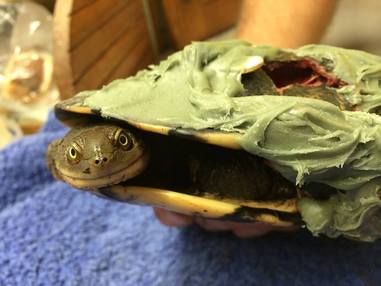These ancient reptiles are diminishing in numbers around the world, mainly due to human impacts.
Freshwater turtles spend most of their time in rivers, lakes, swamps and ponds, including farm dams. However, they sometimes come onto land to migrate between water bodies or to nest. Freshwater turtles found throughout southern New South Wales are threatened by such things as:
|
|
In NSW, introduced foxes in some areas consume over 90% of freshwater turtles eggs. The baby turtles that hatch from the few remaining eggs have to contend with turtle-eating fish, birds and other predators. Adult turtles are protected by their shells from most natural predators when they are in the water, but when they venture onto land they can be killed by dogs and foxes or crushed by motor vehicles. Droughts also take a heavy toll on turtles by drying their habitats and depriving them of food. In addition, turtles when they become entangled in fishing nets are often drowned or if caught on land in discarded netting are killed by a predator.
The Eastern long-necked Turtle (Chelodina longicollis) is the most widespread of the freshwater species, occurring in water bodies throughout NSW with the exception of the highest parts of the Alps. It is easily distinguished by its wide plastron (the under part of the shell), made up of pale yellow shields with black margins. As a defensive reaction to repel predators the Eastern long-necked Turtle can eject pungent liquid gland secretions from its 'armpits' and groin when handled or disturbed. It is a carnivorous species, feeding mostly on small invertebrates such as worms, snails and insect larvae, including mosquitoes. The Eastern long-necked is often seen crossing roads, where unfortunately it is frequently killed by motor vehicles. Please remove turtles to the side of the road they are heading toward. If noticeably hurt as long as there are no severe internal injuries, a cracked or broken shell may be repaired by Wildlife Rescue South Coast or your local wildlife rescue group with artificial materials e.g. fibreglass, before the turtle is released back into the wild.
TurtleSAT - Turtle Surveying and Analysis Tools - is a APP (available from Google play) and website (www.turtlesat.org.au) where communities are mapping the location of freshwater turtles in waterways and wetlands across the country. Australia's unique freshwater turtles are in crisis - their numbers are declining and your help is needed to record where you see turtles in your local area. If you see a freshwater turtle (or a turtle nest) near your local creek, farm dam or on the road, enter the location of your sighting in the APP or on the website. Your sightings will help land managers to track the movement and behaviour of turtles, to protect them and their offspring in your local area.
The Eastern long-necked Turtle (Chelodina longicollis) is the most widespread of the freshwater species, occurring in water bodies throughout NSW with the exception of the highest parts of the Alps. It is easily distinguished by its wide plastron (the under part of the shell), made up of pale yellow shields with black margins. As a defensive reaction to repel predators the Eastern long-necked Turtle can eject pungent liquid gland secretions from its 'armpits' and groin when handled or disturbed. It is a carnivorous species, feeding mostly on small invertebrates such as worms, snails and insect larvae, including mosquitoes. The Eastern long-necked is often seen crossing roads, where unfortunately it is frequently killed by motor vehicles. Please remove turtles to the side of the road they are heading toward. If noticeably hurt as long as there are no severe internal injuries, a cracked or broken shell may be repaired by Wildlife Rescue South Coast or your local wildlife rescue group with artificial materials e.g. fibreglass, before the turtle is released back into the wild.
TurtleSAT - Turtle Surveying and Analysis Tools - is a APP (available from Google play) and website (www.turtlesat.org.au) where communities are mapping the location of freshwater turtles in waterways and wetlands across the country. Australia's unique freshwater turtles are in crisis - their numbers are declining and your help is needed to record where you see turtles in your local area. If you see a freshwater turtle (or a turtle nest) near your local creek, farm dam or on the road, enter the location of your sighting in the APP or on the website. Your sightings will help land managers to track the movement and behaviour of turtles, to protect them and their offspring in your local area.






